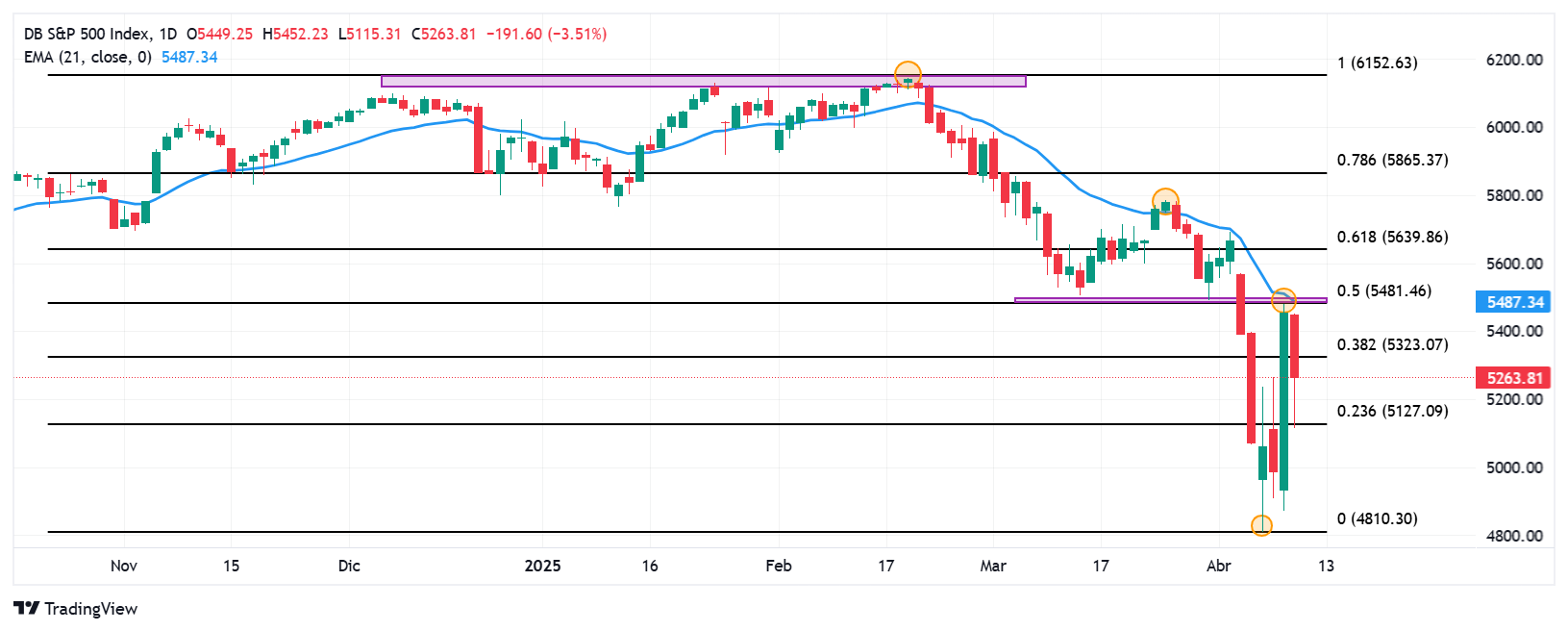- The Dow Jones loses 2.54% today, currently quoting about 39,562.
- The Nasdaq 100 falls 4.16% daily, weighed by microchip technology (MCHP) and Marvel Technology (MRVL).
- The S&P 500 goes back 3.51% on Thursday despite an improvement in the United States CPI corresponding to March.
- Susan Collins, president of Boston’s Fed, warns about an inflation increase caused by tariffs.
The Dow Jones marked a daily maximum in 40,673, finding vendors that dragged the index to a minimum of the day in 39,431.
The industrial average Dow Jones opened in 40,564, while the Nasdaq 100 technological index began operating in 19,143. The S&P 500 began negotiations in 5,449, staying within the range of the previous session.
Nike and Chevron Corporation drag Dow Jones to a negative zone
The Dow Jones index loses 2.58% daily, quoting when writing about 39,508.
Nike titles (NKE) collapse 8.29% today, currently operating at $ 54.40. This fall is presented after the tariff imposition of 145% to the imported goods from China by Donald Trump.
On the other hand, the values of Chevron Corporation (CVX) sink 7.57% on Thursday, reaching minimal not seen since July 13, 2022 in 133.45 $.
In this scenario, Dow Jones falls 1031 points in the day, in tune with the main share rates after the tariff climb between the United States and China.
MicrocHip Technology Incorporated and Marvel Technology lead the losses in Nasdaq 100
The Nasdaq 100 technological index falls 4.16% in the day, consolidating within the previous session at 18,332.
The actions of Marvell Technology (MRVL) collapse 13.27% today, operating currently over 52.87 $.
In the same tune, the values of microchip technology (MCHP) lose 13.56% daily, quoting when writing about $ 38.81, leading losses in Nasdaq 100-
The Nasdaq 100 presents an increasing volatility, intensified by the tariff imposition of 145% to products from China by the administration led by Donald Trump.
The S&P 500 loses almost 200 points despite the improvement of the United States CPI
The consumer price index decreased to 2.4% annualized in March, improving the estimated 2.6% and 2.8% observed the previous period.
On the other hand, the weekly applications of unemployment subsidy were located in 223,000 in the week that ended on April 5, complying with market estimates, although standing above 219,000 of the observed in the previous week.
The president of the Boston Federal Reserve, Susan Collins, acknowledged that tariffs will increase underlying inflation above 3% this year, slowing down economic growth.
In this scenario, the S&P 500 loses 3.51% in Thursday’s session, losing 191 points in the day to stay within Wednesday’s range.
Technical analysis of the S&P 500
The S&P 500 established a short -term resistance given by the maximum of March 25 in 5,784. The next key resistance is observed in 6,145 maximum of February 19. To the south, the immediate support is located in 4.810, pivot point of April 7.
S&P 500 DAILY GRAPH

Dow Jones Faqs
The Dow Jones Industrial Avenge, one of the oldest stock market indexes in the world, consists of the 30 most negotiated values in the United States. The index is weighted by the price instead of capitalization. It is calculated by adding the prices of the values that compose it and dividing them by a factor, currently 0.152. The index was founded by Charles Dow, also founder of the Wall Street Journal. In recent years it has been criticized for not being sufficiently representative, since it only follows 30 companies, unlike broader rates such as S&P 500.
There are many factors that promote the Dow Jones Industrial Average (DJIA) index. The main one is the added performance of the companies that compose it, revealed in the quarterly reports of business benefits. The American and world macroeconomic data also contribute, since they influence investor confidence. The level of interest rates, set by the Federal Reserve (FED), also influences the DJia, since it affects the cost of credit, on which many companies depend largely. Therefore, inflation can be a determining factor, as well as other parameters that influence the decisions of the Federal Reserve.
Dow’s theory is a method to identify the main trend of the stock market developed by Charles Dow. A key step is to compare the direction of the Dow Jones Industrial Avenge (DJIA) and the Dow Jones Transportation Average (DJTA) and just follow the trends in which both move in the same direction. The volume is a confirmation criterion. The theory uses elements of maximum and minimum analysis. Dow’s theory raises three phases of the trend: accumulation, when intelligent money begins to buy or sell; Public participation, when the general public joins the trend; and distribution, when intelligent money abandons the trend.
There are several ways to operate with the DJ. One of them is to use ETF that allow investors to negotiate the DJ as a single value, instead of having to buy shares of the 30 companies that compose it. An outstanding example is the SPDR Dow Jones Industrial Avenge ETF (day). Future contracts on the DJ allow the specular operators about the future value of the index and the options provide the right, but not the obligation, to buy or sell the index at a predetermined price in the future. Investment funds allow investors to buy a part of a diversified portfolio of DJ values, which provides exposure to global index.
Source: Fx Street
I am Joshua Winder, a senior-level journalist and editor at World Stock Market. I specialize in covering news related to the stock market and economic trends. With more than 8 years of experience in this field, I have become an expert in financial reporting.







